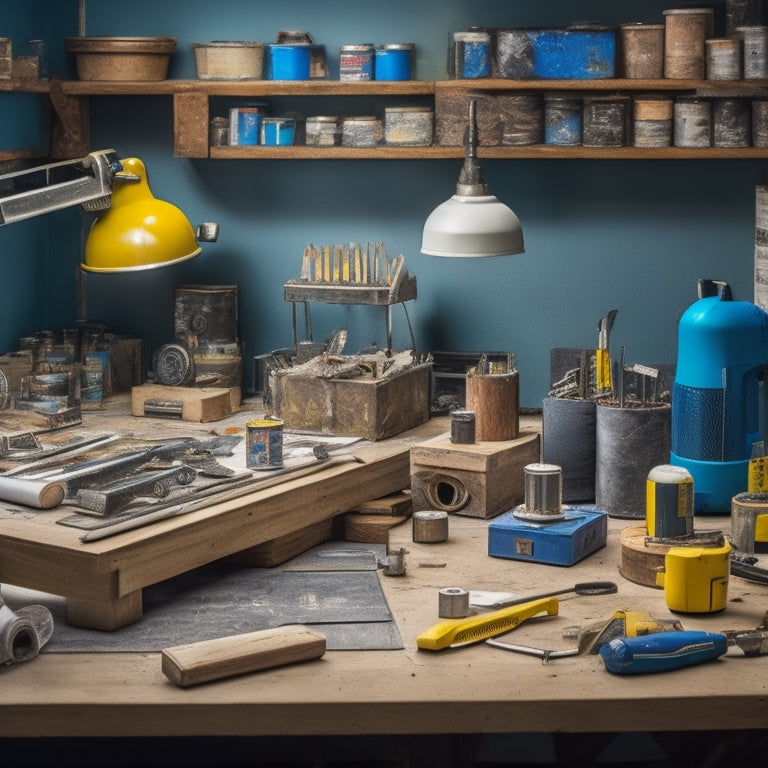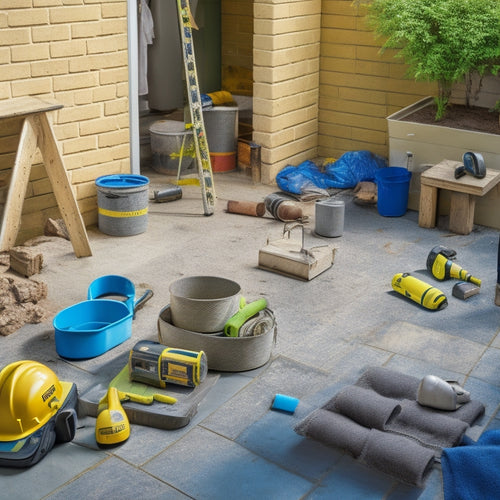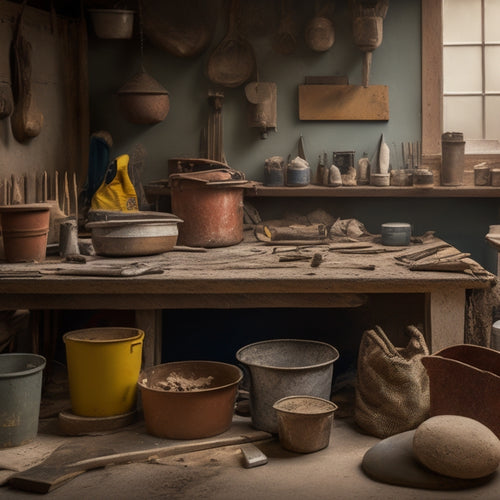
10 Essential Tools for Home Renovation on a Budget
Share
When renovating your home on a budget, focus on essential tools that prioritize efficiency, safety, and quality. Invest in budget-friendly power tools like drills and saws, as well as a DIY painting essentials kit with paintbrushes, rollers, and surface preparation tools. Measuring and marking tools like laser levels, stud finders, and combination squares guarantee accuracy and precision. Don't forget essential safety gear like safety glasses, gloves, and steel-toed boots. Additionally, consider cost-effective flooring options, plumbing fixtures, and electrical solutions. With these tools and strategies, you'll be well on your way to a successful renovation - and there's more to discover to take your project to the next level.
Key Takeaways
• Invest in affordable power tool options like drills and saws with adjustable torque settings and reliable batteries for minor tasks.
• Essential safety gear includes safety glasses, dust masks, ear protection, gloves, and steel-toed boots to prevent injuries.
• A DIY painting essentials kit should include a good quality paintbrush set, paint roller extension pole, surface preparation tools, and paint color chart.
• Measuring and marking tools like laser levels, digital calipers, and carpenter's squares ensure project accuracy and efficiency.
• Cost-effective demolition tools like hammers, pry bars, and wrecking bars facilitate safe and efficient demolition work.
Budget-Friendly Power Tool Options
When it comes to power tools, you don't have to break the bank to get the job done, as there are plenty of budget-friendly options available that can help you stay within your means.
For instance, you can find affordable drill options that are perfect for minor tasks like hanging shelves or assembling furniture. Look for drills with adjustable torque settings and reliable batteries that can last for hours.
If you're in the market for a saw, you'll be pleased to know that there are budget saw choices that can deliver impressive results without burning a hole in your pocket.
Consider a compact circular saw or a reciprocating saw that can handle small to medium-sized projects. These saws are often lighter, more portable, and easy to maneuver, making them perfect for DIY enthusiasts and homeowners.
DIY Painting Essentials Kit
You'll need a solid DIY painting essentials kit to tackle your home renovation project, and fortunately, you can assemble one without overspending. Start by investing in a good quality paintbrush set, which should include various sizes and types of brushes for different surfaces and paint types. Don't forget a paint roller extension pole and a paint tray to make the painting process more efficient.
When it comes to surface preparation, include a putty knife, sandpaper, and a scraper in your kit. These tools will help you smooth out rough surfaces, fill holes, and remove old paint or wallpaper. A paint color chart or swatches will also come in handy when selecting the perfect shade for your walls.
Remember to add some essentials like painter's tape, drop cloths, and a paint can opener to your kit.
With these tools, you'll be well-equipped to tackle your painting project like a pro. By assembling your own DIY painting essentials kit, you'll save money and guarantee a professional-looking finish without breaking the bank.
Measuring and Marking Tools
When you're renovating on a budget, you can't afford to make mistakes that'll cost you time and money.
That's why investing in the right measuring and marking tools is essential - you'll need them to guarantee your projects turn out precise and professional.
From precise measuring devices to marking straight lines and accurate angle measurements, the right tools will help you get the job done efficiently and effectively.
Precise Measuring Devices
With precise measuring devices, you can assure accuracy in your renovation project, saving time and reducing costly mistakes. Having the right tools guarantees that your measurements are spot on, which is critical for a successful renovation.
Here are some essential precise measuring devices to include in your toolkit:
-
Laser level: Projects a level line or dot onto a surface, allowing you to assure that your installations are perfectly level and plumb.
-
Digital caliper: Provides precise measurements of distances, widths, and depths, making it ideal for measuring materials and spaces.
-
Angle finder: Helps you measure and mark precise angles, assuring that your cuts and installations are accurate.
- Stud finder: Locates studs behind walls, making it easier to hang heavy objects or install fixtures securely.
Investing in these precise measuring devices may seem like an added expense, but they'll pay for themselves by reducing errors and saving you time and materials in the long run.
Marking Straight Lines
How do you confirm that the lines you mark on your walls or materials are straight and accurate, especially when working with large surfaces or complex designs?
When it comes to line marking, having the right tools and techniques is essential. A combination of precise measuring devices and effective alignment techniques can make all the difference.
Invest in a good quality straightedge or ruler, which will help you draw straight lines with ease. For more complex designs, consider using a laser level or a chalk line, which can project a straight line across your surface. These tools are especially useful when working with large surfaces or intricate patterns.
To verify accuracy, use alignment techniques such as snapping a chalk line or using a carpenter's square to check your marks. You can also use a pencil and a string to create a straight line, especially when working with curves or irregular shapes.
Accurate Angle Measurements
You'll need to guarantee your angle measurements are spot on to avoid costly mistakes, and that's where a trusty combination square or angle finder comes in. These tools are essential for accurate layout planning and will save you from headaches down the line.
When it comes to angle measurement techniques, you'll want to make sure you're using the right tool for the job. Here are a few must-haves:
-
A combination square for measuring and marking precise angles and straight lines
-
An angle finder for calculating complex angles with ease
-
A protractor for measuring angles in degrees
- A bevel gauge for transferring angles accurately
Affordable Flooring Installation
When it comes to affordable flooring installation, you'll want to weigh the pros and cons of different flooring options to find the best fit for your budget.
You'll also need to take into account the installation method, as this can greatly impact the overall cost.
Flooring Options Compared
By reflecting on your lifestyle, budget, and personal taste, you can narrow down the vast array of flooring options to find the perfect fit for your home renovation project. With so many choices available, it's crucial to weigh the pros and cons of each to make an informed decision.
Here are some popular flooring options to reflect on:
-
Hardwood Alternatives: Engineered wood, bamboo, and laminate flooring offer a similar look to hardwood at a lower cost.
-
Carpet Comparisons: Berber, plush, and frieze carpets vary in durability, maintenance, and price, so choose wisely based on your lifestyle.
-
Luxury Vinyl Tiles (LVT): Water-resistant, low-maintenance, and budget-friendly, LVT is an excellent option for high-traffic areas.
- Ceramic or Porcelain Tiles: Durable, easy to clean, and resistant to moisture, these tiles are perfect for kitchens, bathrooms, and entryways.
Budget-Friendly Installation Methods
Careful planning and strategic decision-making can greatly reduce the cost of flooring installation, allowing you to allocate more resources to the actual flooring material itself. By adopting budget-friendly installation methods, you can save money without compromising on quality. Here are some creative installation techniques to evaluate:
| Technique | Description | Cost Savings |
|---|---|---|
| DIY Installation | Take on the installation process yourself to eliminate labor costs. | 50-70% |
| Staggered Installation | Install flooring in sections, rather than all at once, to reduce waste and minimize labor costs. | 20-30% |
| Floating Installation | Use a floating installation method to reduce the need for glue and nails, saving on materials and labor. | 15-25% |
| Reuse Existing Subfloor | Inspect and repair the existing subfloor instead of replacing it, reducing material costs. | 30-40% |
Essential Safety Gear Checklist
You'll need to gear up with the right safety equipment to protect yourself from potential hazards on your home renovation project. Remember, safety should always be your top priority, and investing in personal protective gear is a must. Here are the essentials you shouldn't skip:
-
Safety glasses: Protect your eyes from debris, dust, and chemical splashes.
-
Dust mask: Prevent inhaling harmful particles and dust when working with power tools or in dusty areas.
-
Steel-toed boots: Guard your feet against heavy objects, sharp edges, and slippery surfaces.
- Work gloves: Shield your hands from cuts, abrasions, and splinters.
Don't underestimate the importance of safety gear. Even minor accidents can lead to serious injuries and costly medical bills.
By wearing the right personal protective equipment, you'll be able to tackle your renovation project with confidence and peace of mind.
Stay safe, and you'll be able to enjoy the fruits of your labor for years to come.
Cost-Effective Demolition Tools
When tackling demolition work, invest in cost-effective tools that'll help you rip out old fixtures, tear down walls, and clear the way for new construction.
You don't need to break the bank to get the job done efficiently and safely.
Start with the essentials: a quality hammer, pry bar, and wrecking bar.
These tools will help you dismantle walls, remove flooring, and rip out cabinets without breaking a sweat.
Budgeting for Building Materials
As you start budgeting for building materials, you'll need to estimate how much each material will cost.
You can't afford to overspend, so it's essential to get accurate estimates and optimize your supply chain to avoid costly delays.
Material Cost Estimation
Estimating material costs accurately helps prevent budget blowouts and guarantees your renovation project stays financially on track. To get it right, you need to develop a solid understanding of your material sourcing strategies and renovation cost breakdown. This involves breaking down your project into smaller components, identifying the materials required for each task, and researching their costs.
Here are some essential steps to help you estimate material costs accurately:
-
Measure twice, order once: Double-check your measurements to avoid ordering excess materials and wasting money.
-
Research suppliers: Compare prices from different suppliers to find the best deals.
-
Consider alternative materials: Look for cost-effective alternatives that can achieve the same result.
- Pad your budget: Add a 10-20% contingency to your material cost estimate to account for unexpected expenses.
Optimizing Supply Chain
You'll need to streamline your supply chain to guarantee timely and cost-effective delivery of building materials, which is essential to staying within your budget. Effective supply chain logistics can make all the difference in keeping your project on track and avoiding costly delays.
Start by identifying reliable suppliers and negotiating the best prices for your materials. Consider partnering with local suppliers to reduce transportation costs and lead times.
Implementing a robust inventory management system will also help you track your materials and avoid stockouts or overstocking. This will enable you to identify areas where you can optimize your supply chain and make adjustments as needed.
Plumbing Fixtures on a Shoestring
Upgrading plumbing fixtures can make a significant impact on your home's overall look and functionality, but it doesn't have to break the bank. You can achieve a high-end look without the hefty price tag. Here are some budget-friendly options to contemplate:
Shop during sales: Keep an eye out for discounts and clearance events at home improvement stores to score affordable faucets and budget sinks.
Think about refurbished or used fixtures: You can find gently used or refurbished plumbing fixtures online or at local salvage yards, often at a fraction of the cost of new ones.
Opt for mid-range brands: Instead of going for high-end designer brands, look for mid-range options that offer quality and style at a lower price point.
DIY installation: If you're comfortable with DIY projects, consider installing your new plumbing fixtures yourself to save on labor costs.
Economical Electrical Solutions
Having tackled the plumbing fixtures, it's time to turn your attention to the electrical aspects of your home renovation, where making smart choices can also save you a pretty penny. When it comes to electrical solutions, it's crucial to prioritize energy efficiency to reduce your carbon footprint and lower your utility bills. Here are some budget-friendly options to evaluate:
| Upgrade | Cost Savings | Energy Efficiency |
|---|---|---|
| LED Lighting | 50-75% | High |
| Smart Plugs | 20-30% | Medium |
| Energy-Efficient Outlets | 10-20% | Low |
Thrifty Tiling and Grouting Tools
When it comes to tiling and grouting, investing in the right tools can make a significant difference in the quality of your work and the amount of time you spend on the task. You don't need to break the bank to get the job done, though. With a few thrifty tools, you can achieve professional-looking results without sacrificing your budget.
Here are some essential tools to add to your tiling and grouting arsenal:
-
A notched trowel for applying tile adhesive with precision and ease
-
A grout float for smooth, even grout application
-
A grout sponge for cleaning excess grout from tile surfaces
- A tile cutter or tile nippers for making precise cuts and shapes
Frequently Asked Questions
Can I Renovate My Home Without Professional Help?
You're thinking of taking on a DIY renovation, but wondering if you can really do it without professional help. The answer is, yes, you can!
With some solid DIY renovation tips and budget renovation strategies, you can tackle many projects on your own. Start by identifying areas where you can save money, like repurposing materials or doing demo work yourself.
Then, focus on one task at a time, and don't be afraid to ask for advice when you need it. With patience and persistence, you can achieve your renovation goals.
How Do I Handle Asbestos During Demolition?
When handling asbestos during demolition, you'll want to prioritize caution.
First, you'll need to get asbestos testing done to identify contaminated areas.
If tests come back positive, don't attempt removal yourself - it's not worth the health risk.
Instead, hire a certified professional for safe removal. They'll have the proper gear and know-how to contain and dispose of the hazardous material.
What Are the Most Common DIY Renovation Mistakes?
When tackling a DIY renovation, you'll want to avoid common mistakes that can derail your project.
One major pitfall is poor planning, which can lead to costly delays and changes.
Unrealistic budgeting is another mistake that can leave you financially strained.
You'll also want to watch out for inadequate prep work, poor material choices, and not planning for contingencies.
Can I Reuse Old Materials in My Renovation Project?
As you commence your renovation journey, you're like a phoenix rising from the ashes, transforming the old into something new.
Can you reuse old materials? Absolutely! You're not only reducing waste but also giving new life to what's been discarded.
Consider reclaimed materials for upcycling projects that breathe fresh air into your space. Salvage old doors, windows, or flooring to create unique features that tell a story.
Get creative, and you'll be amazed at what you can repurpose, reducing costs and environmental impact.
How Do I Dispose of Hazardous Renovation Waste?
You'll need to dispose of hazardous renovation waste responsibly to avoid harming the environment and your community.
Identify hazardous materials like asbestos, lead paint, and chemicals, and separate them from non-hazardous waste.
Check with your local authorities for hazardous waste disposal facilities or recycling programs.
You can also explore renovation waste recycling options to reduce landfill waste and minimize environmental impact.
Conclusion
You've made it to the final stretch of your home renovation journey!
With these 10 essential tools, you've cut corners without cutting quality.
Remember, when it comes to renovating on a budget, it's all about working smarter, not harder.
You've learned to 'bite off what you can chew' and prioritize your spending.
Now, take a step back, admire your handiwork, and get ready to enjoy your newly revamped space!
Related Posts
-

7 Patio Safety Tips for DIY Renovation Projects
As you begin your DIY patio renovation project, prioritize safety by evaluating the worksite for tripping hazards and...
-

What Plastering Tools Do You Need for Renovation
You'll need a range of specialized tools to tackle a plastering renovation project efficiently and effectively. Essen...
-

Streamline Your Exterior Renovation Timeline
To streamline your exterior renovation timeline, you'll need to approach the process strategically. Start by planning...


